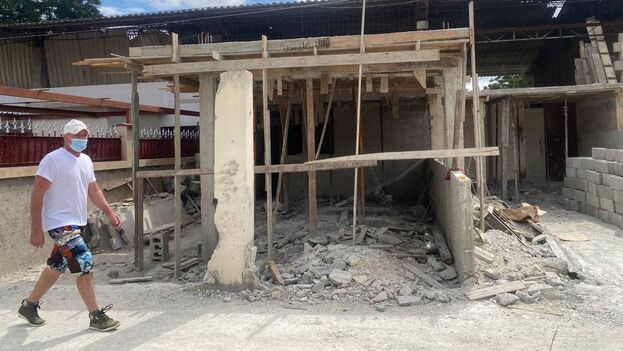
![]() 14ymedio, Havana, 27 March 2021 – Amid the rise in prices brought about by the ‘Ordering Task’, the prices of cement and some other construction materials will not vary, according to a report on Cuban Television’s Roundtable program this Friday. However, the product has disappeared from the State stores and is only found on the black market, where its price is increasing.
14ymedio, Havana, 27 March 2021 – Amid the rise in prices brought about by the ‘Ordering Task’, the prices of cement and some other construction materials will not vary, according to a report on Cuban Television’s Roundtable program this Friday. However, the product has disappeared from the State stores and is only found on the black market, where its price is increasing.
The shortage of materials has hit home construction hard, Cuba’s Minister of Internal Trade Betsy Díaz Velázquez, acknowledged. Since last January and after the economic adjustments, there has been a reduction in the sale of materials in the 343 state stores of this type that operate in the country.
“Fundamentally, products with inventories before December 31 have remained on offer” the Minister detailed, appearing with the Ministers of Industries and Construction. Even when some of these materials reach the so-called ‘remnants’, they are reserved only for subsidized clients and those affected by hurricanes, she added.
In the case of cement, the 42.5-kilogram bag of Portland P-350 maintains its price of 165 pesos, but the minister could not specify whether the product will return to the state stores that set prices in the national currency, from where it disappeared more than a year ago.
The only option to get the products at the moment is the informal market, where the price of a single bag exceeds 1,000 Cuban pesos (roughly $40 US); or go to the foreign currency stores where it costs 10 dollars and is scarce. Díaz explained that the production plan for this year is 1.02 million tons, slightly higher than 2020, but far from the 4.27 million tons that the Island produced in 1958.
“This product has a centralized wholesale price and maintains the current retailer from before the Ordering Task,” Díaz clarified. In order not to raise its price on the remnants, the State adopted the decision to “finance the losses so as not to pass on the inefficiency or obsolescence of the factories to the population.”
The minister’s statements provoked dozens of comments, most of them with complaints about the lack of supply. “Yes yes yes. All very nice. But where are those materials. If all the materials are under the counter,” lamented an Internet user on the official Cubadebate website that reproduced Díaz’s statements.
“So many subsidies from the state budget only mean that production is not going to be even remotely similar to the demand for these materials. Only what was planned will be produced,” lamented another reader who predicted that as soon as the sacks reached “the warehouses they will already have an owner and the resellers will charge a lot for these products.”
In 2019 there were six cement factories throughout the Island, but the sector has been at half-speed for decades, after the fall of the socialist camp and the end of Soviet subsidies.
In recent years, cement has become a rare “gray gold” that is eagerly sought by all those who want to repair a kitchen, modernize a bathroom or touch up a facade. Since 2018, the product barely appears in stores in Cuban pesos and is rationed in state supplies set aside for victims of natural disasters.
According to the statistical analysis site Foresight Cuba, the island occupies “the last place in terms of cement consumption per inhabitant in Latin America,” excluding Haiti, a country for which no data is available. The average consumption of Latin America in 2017 was 278 kg per inhabitant, but Cuba consumes only 45% of that average, according to data from the Inter-American Cement Federation.
The shortage was exacerbated by a tornado hitting Havana in January 2019. With thousands of homes affected, the State guaranteed a 50% discount on the cost of construction materials for people with homes damaged by the disaster in the neighborhoods of Luyanó, Regla, Guanabacoa and Santos Suárez.
With the monetary unification and the rise in many prices of products and services since January 1, the situation has worsened. Cement has become a fixture in the growing barter on classifieds sites where it is traded for pork, mobile phones and even powdered milk.
____________
COLLABORATE WITH OUR WORK: The 14ymedio team is committed to practicing serious journalism that reflects Cuba’s reality in all its depth. Thank you for joining us on this long journey. We invite you to continue supporting us by becoming a member of 14ymedio now. Together we can continue transforming journalism in Cuba.
